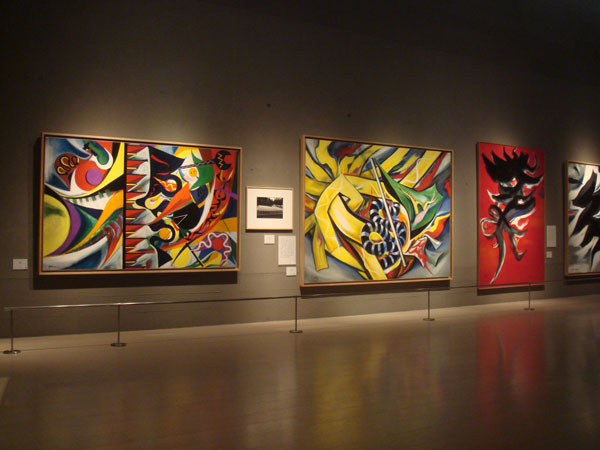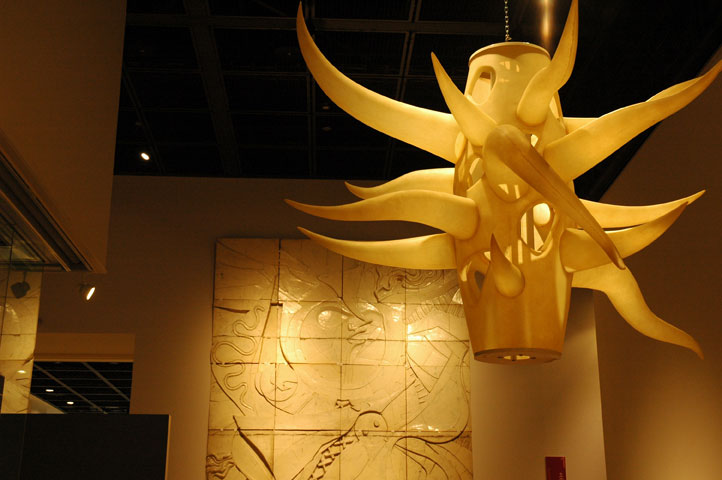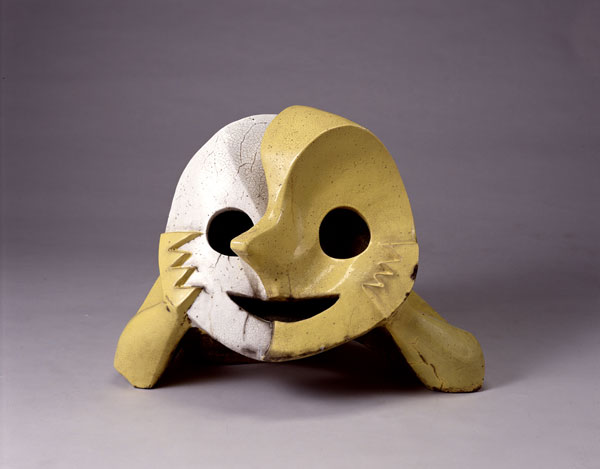The Modern Art of Ancient Folklore
It seems fitting that to reach Kawasaki’s Taro Okamoto Museum of Art one follows a path through a hushed, shady forest park of tall old trees, like a short journey into Japan’s quieter and less urbanized past. Although Okamoto was a modern artist, his work was informed by ancient cultures and traditional rural Japan as much as by the European avant-garde, and the area is certainly more like the Kawasaki where he was born in 1911 than the one most people experience today. The modern museum itself, partly underground, with a huge sculpture looming behind it, is at the top of a broad stairway leading up into the sunlight. Inside it is slightly maze-like, making it seem larger than it is, and creatively designed with curving walls and unexpected spaces and details, such as tiny televisions beneath a glass floor and photo-projections on the wall. In this way, the museum does a good job of reflecting the idiosyncratic artist and his various creations, which are thoughtfully and imaginatively exhibited.

One of the first displays beyond the red-lit entrance is a round room devoted to the life of Okamoto, his cartoonist father and novelist mother, where a chronology (one of the museum’s few English-language displays) lists highlights of his life and career as a painter, sculptor, photographer and writer. Here we learn of his survival of five years military service in China and his death in 1996, as well as his education in Paris and later interest in Japan’s prehistoric Jomon people, two of the main influences on his work.
Europe was where Okamoto first saw Picasso’s paintings, an experience that had a more obvious influence on his art than the study of ethnology that followed. However, there is clearly a connection between his studies in Paris and his later interest in ancient Japanese culture, which in turn had a great effect on his art. Marcel Mauss, Okamoto’s teacher at the University of Paris, who authored The Gift, an influential book about the power and significance of gifts in primitive societies, surely encouraged the young artist’s respect for and curiosity about primitive peoples and their traditions. Upon his return to Japan, Okamoto began his study of Japanese folkways and the Jomon people in whose ancient art he saw much beauty. His photos of Jomon earthenware, with its distinctive faces and loopy, spiral designs, are displayed in a hall leading to the first large exhibition room.
Many of Okamoto’s paintings, which after his return to Japan were influenced by his experiences traveling the country and delving into the darker corners of its traditions, are on display. Filled with bold colors, abstract designs, zigzags and snaky lines, the paintings are sometimes capable of an unexpectedly powerful emotional impact, but with good reason his sculptures are given equal, if not more attention. The first of these is a miniature version of the Tower of the Sun, the huge monument designed and built for the 1970 Expo in Osaka. This most famous of Okamoto’s works is adorned with very Jomon-like faces and an organic design that the government, wanting something more futuristic and technological, were not too pleased with, but which the public demanded not be torn down after the Expo ended. Nearby, a number of Okamoto’s imaginative chairs can be sat upon, including several stools called The Chair that Refuses Sitting and a wavy red two-person seat titled Terrible Child. From here, a short ramp curves down to the museum’s centerpiece, a dark and atmospheric space filled with some of the artist’s most impressive sculptures. White and bulbous, Tree Man (1968) stands at the center, while a metal bell covered with Okamoto’s typical horn-like protrusions hangs in a triangular alcove. Among a series of intriguing smaller works, Young Clock Tower (1966) is a silver, robot-like figure with a clock face from Japan’s neon future, while Spirit of Tree (1971) is a grey, tentacled, gaping-mouthed creature from the not-so-distant past when tree spirits were a common part of everyday Japanese mythology. Here again we see the influence of Okamoto’s travels in rural Japan and study of its beliefs and traditions, some of which have their roots in Jomon times.
The permanent collection ends with a passage featuring Okamoto’s photography and, rather less impressively, a television showing the various commercials he appeared in. Taro Okamoto’s famous expression, “art is explosion,” related to his belief that good art is produced by discord, but it is a bit difficult to reconcile this somewhat subversive attitude with images of the artist selling batteries, whiskey and video cassettes.

The museum’s current temporary exhibit, which in the past has included The Legend of Ultraman and decorative coffins from Africa, is a collection of Okamoto’s three-dimensional art. Defying Dimensions showcases dozens of his creations, many with characteristics that will be familiar after a look at the permanent collection: blob-like objects; smooth, curving lines; horns and spikes. Thousand Hands, a three-dimensional version of the powerful painting of the same name, is an arresting aluminum sculpture of four interlaced heads and hands, while Warrior resembles a long grey tongue with white fangs sprouting from its surface. A man-sized Spirit of Tree with large menacing horns, and various other shapes and figures, some standing on the floor, others hung on the walls, fill the large room.

Predictably, a gift shop waits at the end of a visit to the Taro Okamoto Museum of Art, and across from the cash register two capsule toy-dispensers stand side-by-side. Put a couple of coins into one, turn the handle, and a plastic ball containing a tiny example of Jomon earthenware will come out. Put your coins in the other, and the plastic ball will hold a reproduction of a classical European sculpture. One suspects Taro Okamoto would certainly have approved.
A. S. Feinberg
A. S. Feinberg


